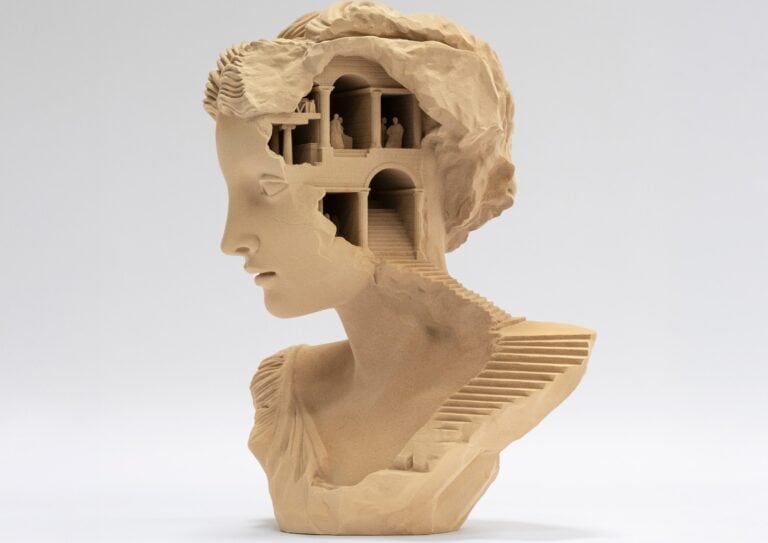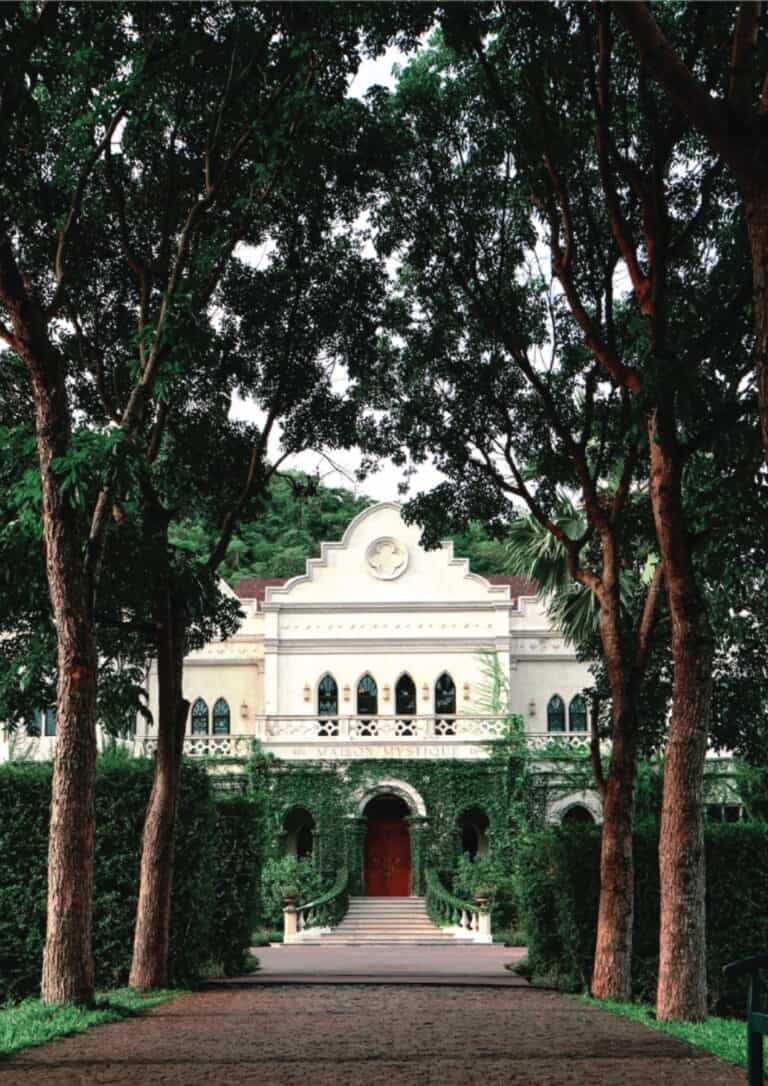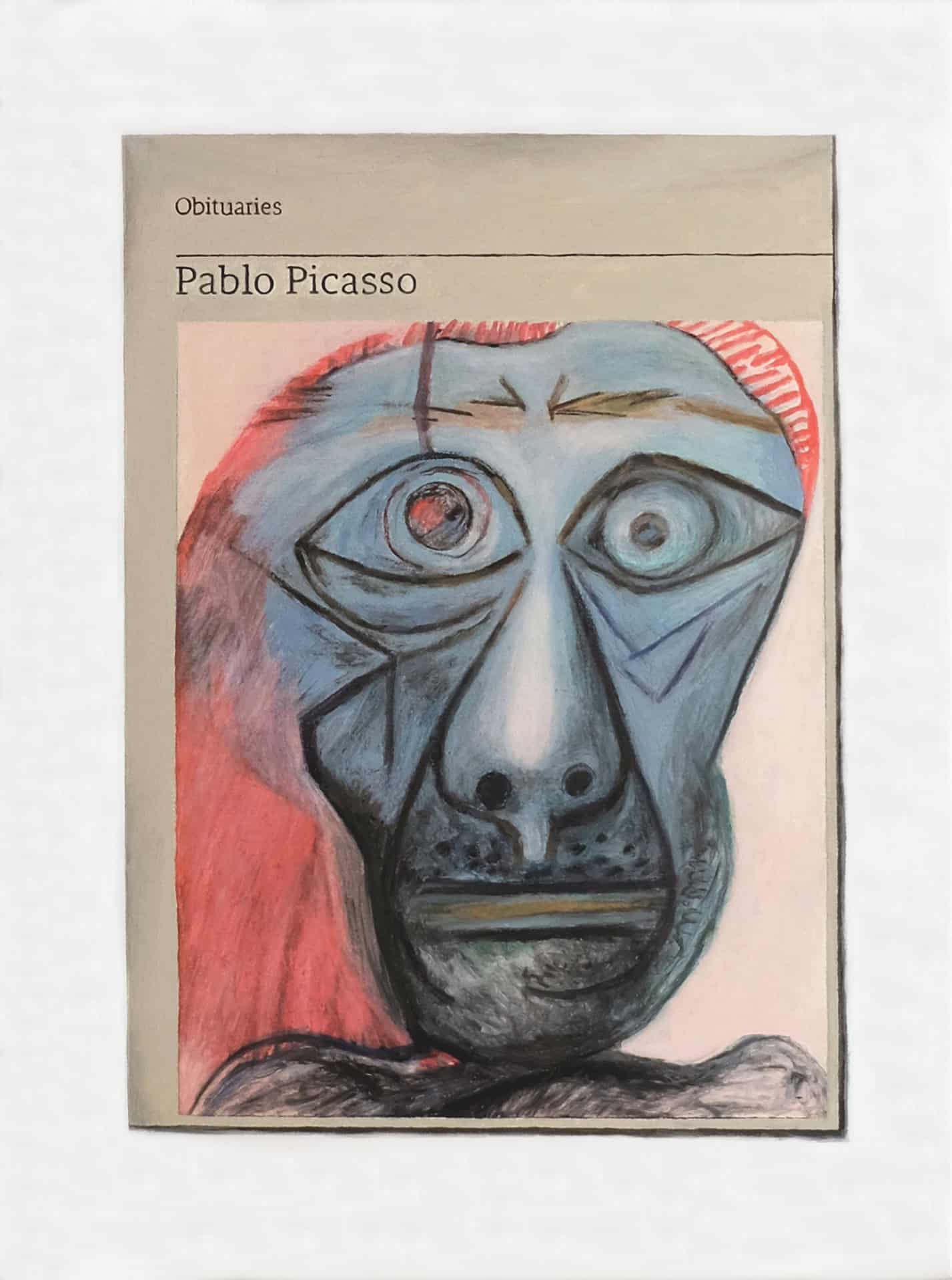
Autorretrato: Hugh Mendes
Natasha Hall
Hugh Mendes’ third solo exhibition with the CHARLIE SMITH LONDON opens this week, and the artist describes his obituary works as ‘celebrations, as well as memorials. One day in the newspaper is not enough. They are still lives, vanitas, memento mori’. Looking through an imaginary mirror to capture the piercing stare of an historic artist transferred from digitally printed source material to canvas, Autorretrato is Spanish for a self-portrait and Hugh Mendes chose it as the title of the show as the majority of the artists included in the show are Spanish.
Zavier Ellis, the director of CHARLIE SMITH LONDON, described how ‘in its totality Mendes’ oeuvre reminds us of our macabre preponderance for death, terror and the state of mankind by relentlessly presenting us with modern day ‘momento mori’. The transience of ubiquitous headlines and the magnitude of historical events that generate them combine with an uncanny personal history laden with experiences that feed back into the work where war and loss are never far away, thus creating permanence from the ephemeral and personal from the universal’ (1).
‘From the horror of a 92 year old Picasso staring death in the face, to a young rather petulant looking Egon Schiele, to an old somewhat resigned but achingly profound Rembrandt that I have been visiting at Kenwood House for the last 30 years or so…I hope these paintings seen together will act as a memorial and somewhat devotional musing on what can be seen as my own personal lineage in the history of painting… perhaps a magnum opus.’
The work included in Autorretrato embraces the era of fake news by consisting of completely invented obituaries, whilst delving into the past to inform the depth of understanding of each artist represented to re-explore the traditional notion of the self-portrait.
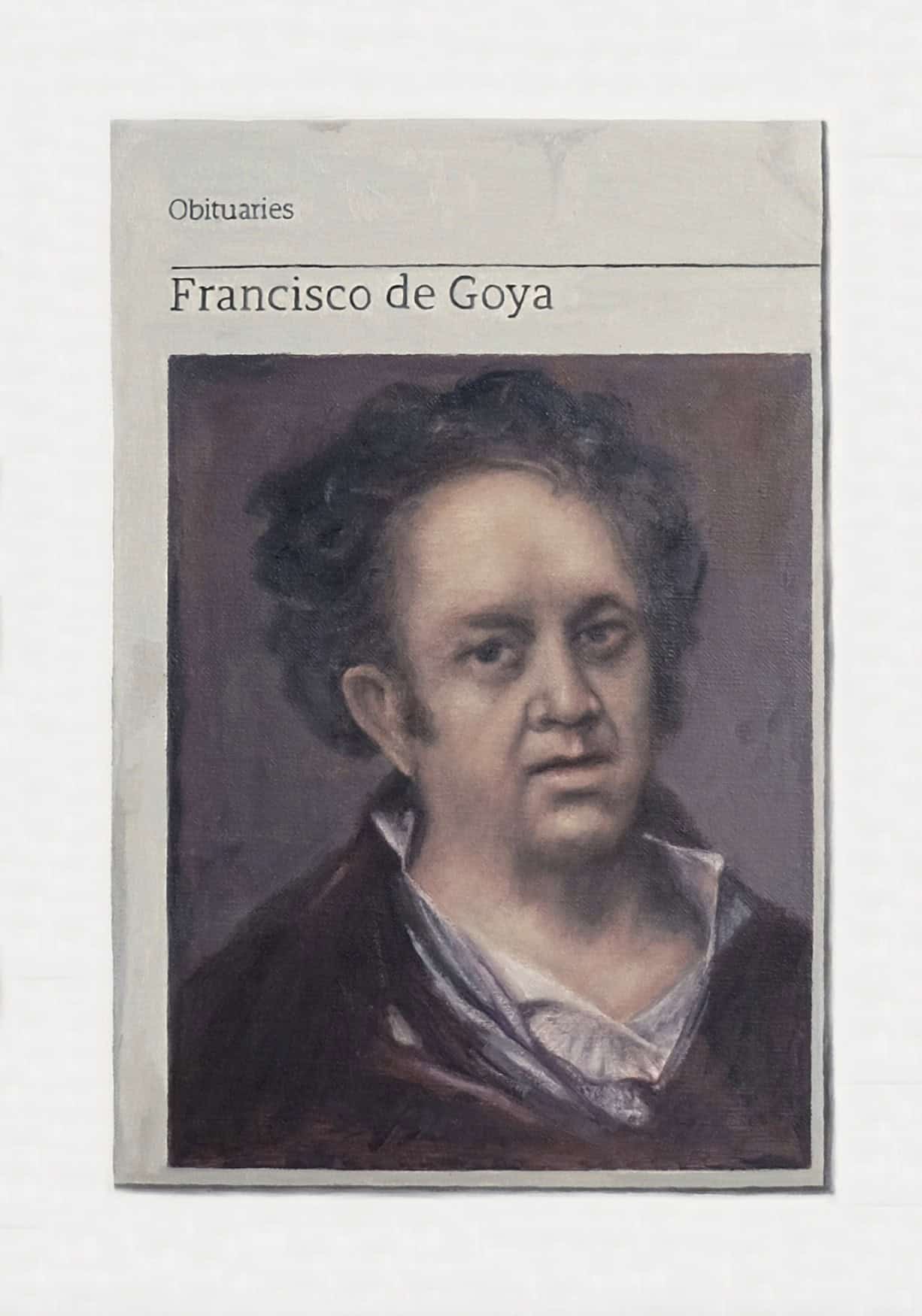
Hugh Mendes | Obituary: Francisco de Goya | 2018 | Oil on linen | 35x25cm
In interview with IRK Magazine, Hugh Mendes reveals unique insights into his creative process, the role of homage and the importance of individual works in the show:
IRK: Having seen your earlier, more political work, especially the MA show on September 11th 2001…
HM: You remember that ?
IRK: Yes, I attended the PV and you were exhibiting a work of Bin Laden.
HM: It was a picture of Bin Laden pointing a gun at George Bush’s head, to do with the false election result, when he got into power and the headline said that Al Gore really did win Florida, when they finally recounted it, but by then they had already made Bush president. I thought that what he had won really was an Arab pointing a gun at his head. It was a symbolic gesture. On 9/11 I was at home as the tutors were marking the show, and I turned on the tele, and I immediately videotaped it. I had been recording The Simpsons the night before.
IRK: Such a contrast !
HM: So I have got a VHS tape somewhere, that goes Simpsons, Simpsons, Simpsons, 9/11. Just like that in sequence.
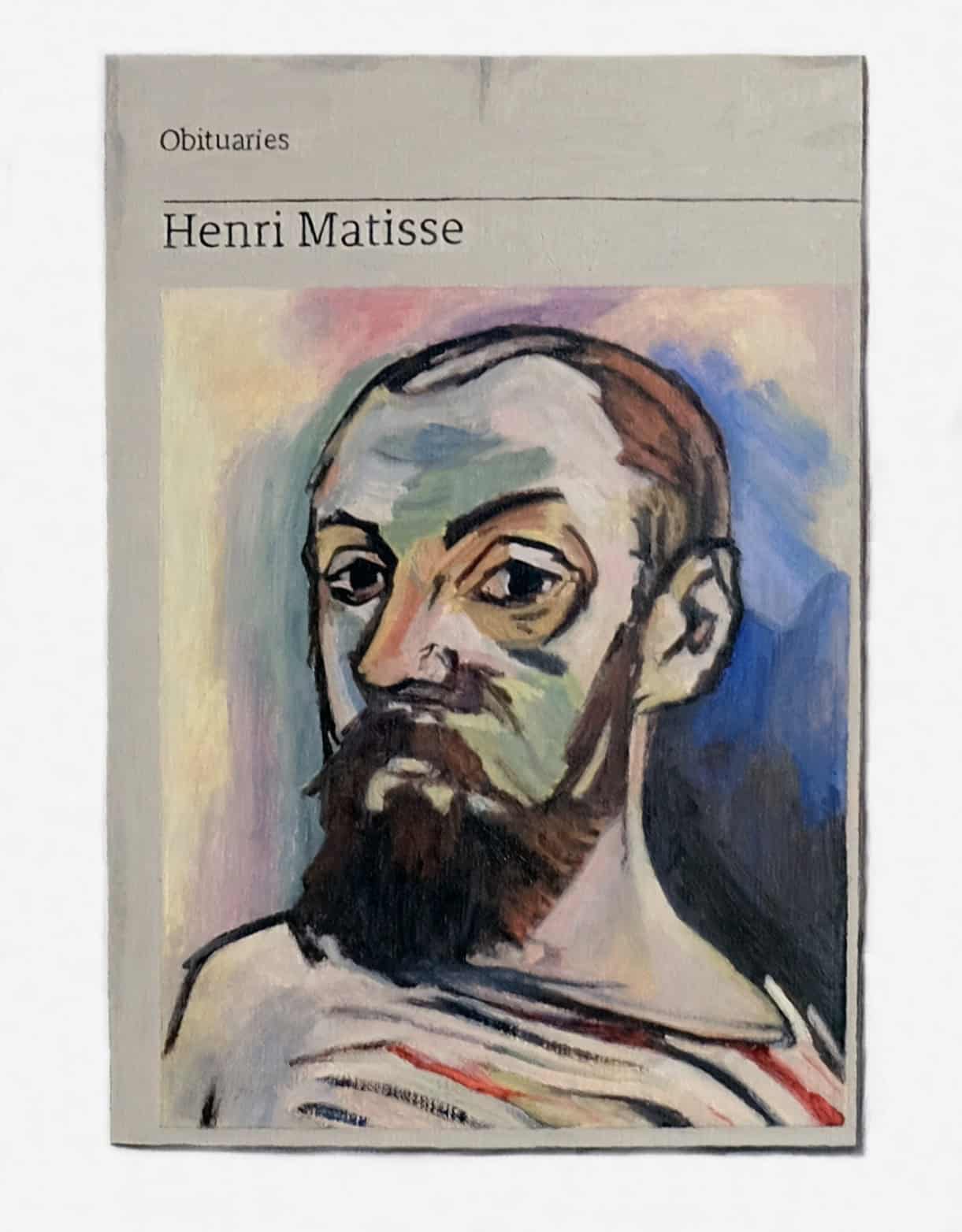
Hugh Mendes | Obituary: Henri Matisse | 2018 | Oil on linen | 35x25cm
HM: I did a 10th anniversary show 9/10/11 with Kenny Schachter, a New York Gallerist who was there at the time. For the 10th anniversary of Bin Laden, they did actually assassinate him, so I painted his obituary for that show. In The Times obituary of Bin Laden, there was a four page obituary, and they listed all of the people that had died on 9/11. So I thought, I would write out all the names in pencil. I worked out that if I wrote out 75 names per day, every day for six weeks, then that would equal 3000 names. So I sat there, for six weeks, writing them all out, on three sheets of A3 paper. Kind of in the same format as it was in The Times. It is in the Nobel collection in Zurich, a collection based on newspapers in art, and it was a real labour of love.
‘The basic idea of the the piece was to pay homage. That it would be an appropriate memorial piece. As I write out each name I think that’s another person, who died that day, so unexpectedly, so shockingly. They had a family; a mother, father, wife, husband, children, etc. I also think about what actually happened to them? Which ones were the jumpers? Apparently about 200 people jumped from the towers. Which ones were blown to pieces immediately on impact? They are all listed alphabetically. I also think quite a lot had unusual names… That’s another random person. I look out for names that are familiar, similar to people I know. It’s a meditative piece. It is an extended meditation on those people.’ (2)
IRK: There is a real duality between the 9/11 and the obituary work.
HM: Kind of, they have got this mortal theme in common, Nature Morte, they are all still life, they are all newspaper clippings which are flat, two dimensional still life essentially.
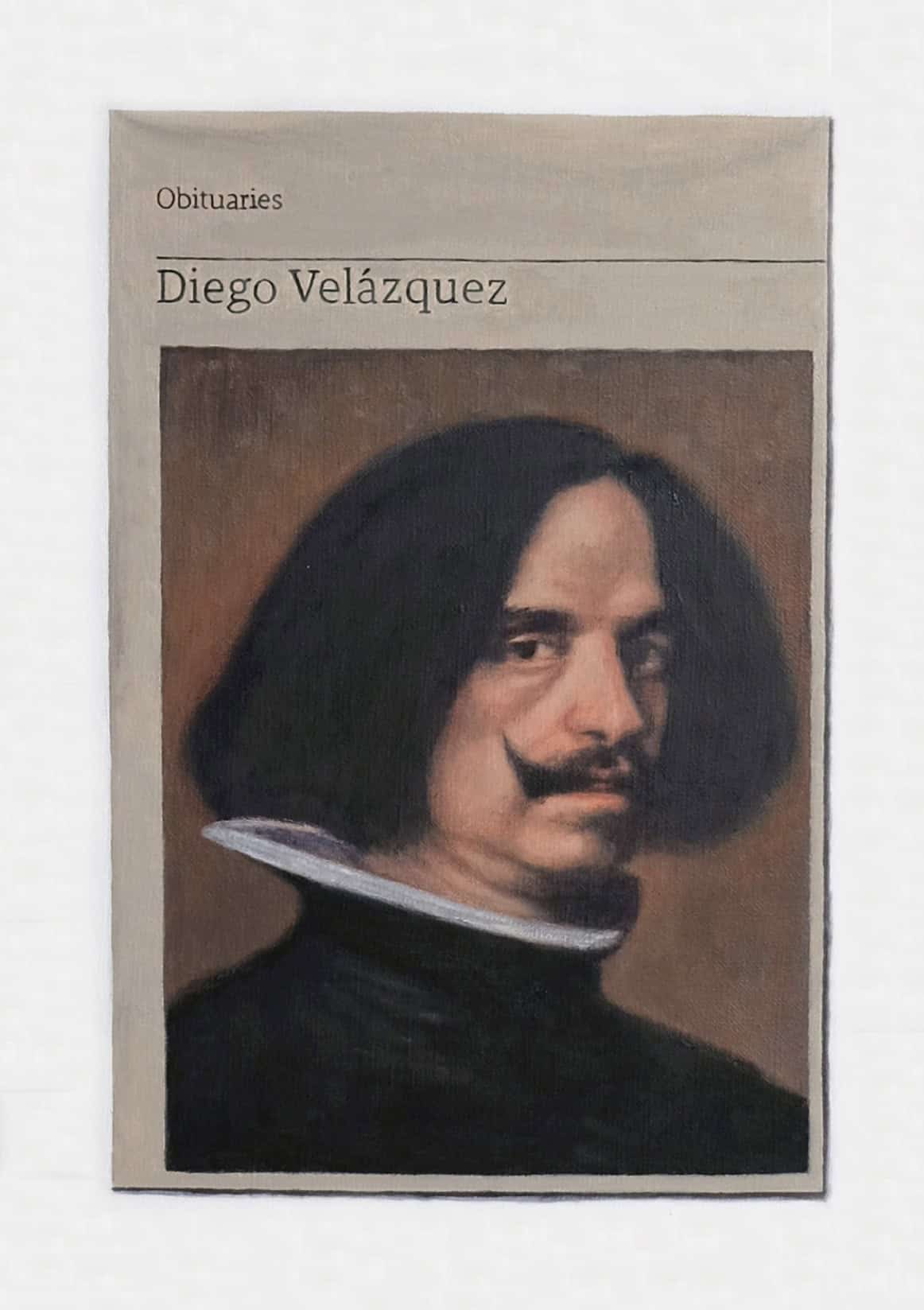
Hugh Mendes | Obituary: Diego Velázquez | 2018 | Oil on linen | 35x25cm
HM: Its been really nice that I can sit and be with them, because it is very personal. Velázquez there, he is staring at me! You will notice that they are all looking at you full on.
IRK: What I love about the paintings is that they really jump off the wall and out of the work, and you seemed to have responded to the paintings themselves.
HM: It is so different to working from a photograph. Goya there, for example, I had so much trouble with him. He was really, really hard, because he was such a delicate, subtle painter. By comparison, Velázquez came out really easy, because he is almost graphic by comparison. A lot of black. Picasso is terrified, he is staring his own death in the face, he just painted that in the year that he died, and he knew he was dying. The horror, the masked face.
IRK: The press release for the show talks about your communication with the artists.
HM: Yes, it feels like that. Like channelling them. I talk to them, like in that short film by Sogand Bahram in my studio last year. I would go into the studio in the morning, and I would be chatting away to Lucien Freud on the easel there, waiting for me. He would be asking ‘where have you been? I have been siting here all night!’. It felt a bit like that. Its been fun pretending that I have a dialogue with them.
‘ I am doing all this because I am another dead artist, waiting in the wings, my turn will come ’ (3)
HM: The thing with the obituaries is that I keep deviating, meandering through and now they are all made up. They are all my own, personal, made up obituaries. Apart from the fact that I am using the ex-Guardian font, its got nothing to do with newspapers anymore. I am pretending I am using a newspaper format.
IRK: How much of your research is online?
HM: I work all of the time on it. I was watching documentaries about Velázquez, and Goya, and their life story. Its part of my channeling, getting into their life story; what they did, how they lived, who they knew, who they were taught by, the context, what was going on.
IRK: So there is a lot of research that goes into each painting to connect to their personal stories.
HM: Velázquez was absolutely obsessed with wanting to be royalty. He was lower class, of Jewish ancestry, and he wanted to be royalty. He worked for the king, but was just a servant essentially. He lived and worked for the king for 40 years, and he spent three years in Rome, petitioning the Pope to get his influence, which is why he did that famous painting of the Pope, that Francis Bacon used, and that was all to do with him trying to get himself an aristocratic title.
Which he eventually did get, and then within a year he dropped dead. He was done! He had got what he wanted. They all have these fantastic stories, and luckily we have access to all of them, its so easy.
IRK: Especially the research side of it.
HM: Yes, its really easy, all of the images. I like to go to the museums, and I have spent time with everyone there. I have looked as at many originals as I possibly could, and I tell my students that they have got to spend time in museums, you can’t just spend time online and in books.
‘Everyones lives are completely documented, millions of images. I am slowing down that process of painting newspaper images, as the newspaper just reproduces everyday, and it becomes immediately rubbish, its in the trash can and the next story takes off… they use news events to bury information, so I take it out of the bin and hold it up and make a painting of it, so people can look at it for a longer period and maybe consider things slightly differently’. (4)
A short film made by Sogand Bahram in his Hackney studio captured his engagement with painting Lucian Freud in the run up to the exhibition The Death of the Artist at CHARLIE SMITH LONDON in 2016. It is a wonderful record of the creative process of the artist: The handling of the paint, the freedom of marks and range of colours on the pallet, the engagement of the artists with the source material. Recording the actual newspaper image whilst remaining faithful to the original painting.
‘Using the self imposed format of the newspaper obituary, I have diversified over the last few years. increasingly making up my own versions rather than working from the ‘found object’ …Recently however, I have been working backwards, catching up with artists that died prior to my engagement with painting obituaries’
The Autorretrato exhibition has its roots in The Death of the Artist show, and continues to explore the process of using another person’s self-portrait as source material. From the current show, all of the obituaries are invented and the source for each study was constructed from attaching a self-portrait by each historical artist downloaded from the internet, and attached it to the page of an obituary from a newspaper. It embraced the psychology of the artist and how they saw themselves and allows him to engage with their idiosyncratic use of paint and perhaps consider a degree of existentialism.
https://youtube.com/watch?v=vI0wA0bDeCA%3Fautoplay%3D0%26mute%3D0%26controls%3D1%26origin%3Dhttps%253A%252F%252Fwww.irkmagazine.com%26playsinline%3D1%26showinfo%3D0%26rel%3D0%26iv_load_policy%3D3%26modestbranding%3D1%26enablejsapi%3D1%26widgetid%3D1
Hugh Mendes
Autorretrato
Exhibition Dates
Friday 14 September – Saturday 13 October 2018
Private View
Thursday 13 September 6.30-8.30pm
Address
336 Old St, 2nd Floor, Shoreditch, London EC1V 9DR
Gallery Hours
Wednesday–Saturday 11am–6pm or by appointment
Contact
+44 (0)20 7739 4055
direct@charliesmithlondon.com
charliesmithlondon.com
@CHARLIESMITHldn
Artsy
Footnotes:
1) Zavier Ellis in the 9/10/11 anniversary/memorial exhibition catalogue at the Kenny Schacter/Rove Gallery.
2) In discussion with Jasper Joffe for the 9/10/11 anniversary/memorial exhibition catalogue, at the Kenny Schacter/Rove Gallery.
3) Hugh Mendes in the film by Sogand Bahram (2016) https://youtu.be/vI0wA0bDeCA
#HughMendes #NatashaHall #EuropeanArtEditor #Picasso #PabloPicasso #CharlieSmithLondon #EgonSchiele #Rembrandt #KenwoodHouse #painting #magnumopus #Autrorretrato #FranciscodeGoya #Goya #GeorgeBush #BinLaden #TheSimpsons #HenriMatisse #Matisse #KennySchachter #Nobelcollection #Zurich #DiegoValázquez #Velázquez #Deathoftheartist #JasperJoffe #ZavierEllis #911 #RoveGallery #SogandBahram #Anniversary #Memorial
Share this post
Natasha Hall is an internationally recognized British artist with a doctorate in Contemporary Landscape Painting. She has university qualifications in the arts and the sciences who specializes in interdisciplinary collaborations with scientists, artists and the wider community to realize her projects. Through constantly exploring the limits between the arts and the sciences, from documenting the reality of being a patient, the layering of landscape and the interaction of climate change with historical accounts…she has exhibited, organised conferences and continues to be represented by the Es Baluard Museum of Contemporary Art, the Gabriel Vanrell Art Gallery in Palma de Mallorca, and is delighted to be the European Arts Editor for IRK Magazine.
Read Next


